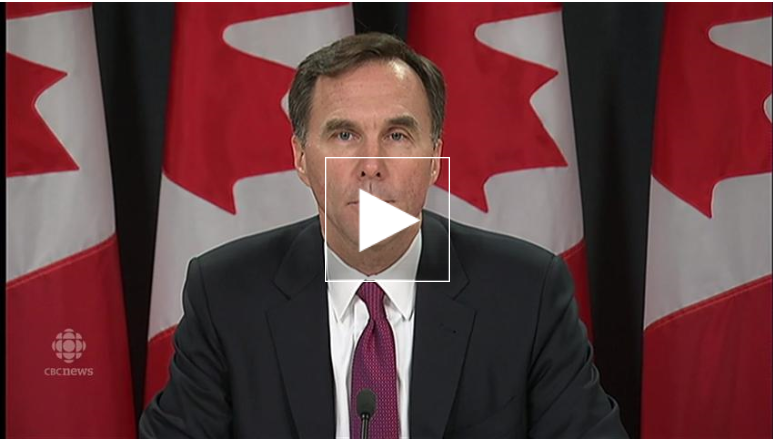The deteriorating economic picture means that the projections of last April are now about $6 billion per year lower, on average, for the next few years. That accounts for the projected $3-billion deficit in the current fiscal year and a larger $3.9-billion deficit next year, before eventually returning to surplus in 2019-2020.
Part of that is the ongoing slump in oil prices. In April, the government was assuming a per-barrel price of $63 US and up for WTI next year. That’s been ratcheted down to $50 US a barrel. Even that lowered figure is $10 above where oil is currently trading, just over $40 a barrel.

Ottawa is also now assuming a weaker loonie, too. In April, the budget was forecasting an 83-cent loonie, on average, between now and 2019. Friday’s fiscal update downgrades that to 79 cents US.
The loonie is currently trading hands at around 75 cents US.
The Liberals had originally planned to post “modest” deficits of $10 billion or under for the first few years of their mandate, but those were based on a budget that was supposed to be currently in surplus.
‘It’s just not possible to cut our way to prosperity.’– Morneau
If the government’s budget is already in the red, those deficits could be much larger than anticipated, but the finance minister deflected numerous attempts by journalists to get him to acknowledge that reality.
The NDP, for its part, said it will hold the government to account to ensure it is financially sustainable while also investing in the economy in the way it said it would during the federal election campaign.
Manageable deficits
At least one major bank said Friday that the new numbers suggest bigger deficits are indeed now in the offing, but Toronto-Dominion Bank said they should be “manageable.”
“Assuming that budget deficits of $10 billion [as promised in the Liberal platform] will be completely additional to today’s starting point, near-term deficits of between $13 billion and $14 billion can be expected when budget 2016 is announced,” the bank said. “At approximately 0.7 per cent of GDP, these deficits appear manageable.”
For comparison purposes, the U.S. government had a deficit-to-GDP ratio of roughly 2.8 per cent last year.
Canada’s Liberal government was quick to stress that the calculations in Friday’s update did not factor in any of the costs of some of the promises the Liberals made on the campaign trail, including big infrastructure spending and a rejigging of the tax code to lessen the burden on middle-income earners at the expense of higher ones.
Read the full post in CBC News Business


Leave a Reply